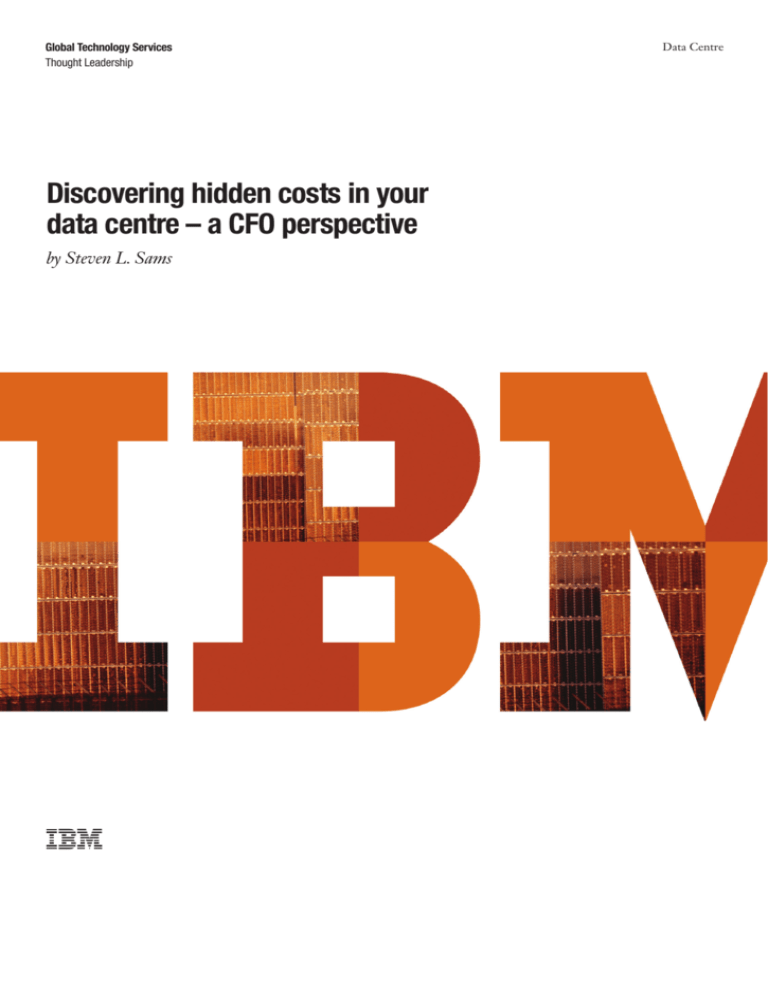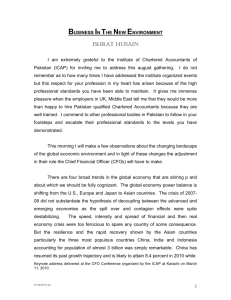
Global Technology Services
Thought Leadership
Discovering hidden costs in your
data centre – a CFO perspective
by Steven L. Sams
Data Centre
2
Discovering hidden costs in your data centre – a CFO perspective
Under a glaring spotlight, Chief Financial Officers (CFOs)
and their Finance organizations have had to address urgent
capital acquisition, cash flow and revenue challenges. Volatility
and uncertainty have drawn them into more frequent
boardroom conversations about forecasts, profitability,
risk management, and strategic decisions related to supply
chains, pricing and production. As a result, CFOs are
emerging with far more influence at the enterprise level,
as IBM determined in a recent global survey of CFOs.
One key area sets top performers apart. When Finance
transforms today’s wealth of financial and operational
information into business insights, they contribute to
significant enterprise value creation. At the June 2010 meeting
of top CFOs at the Financial Executives International (FEI)
Canada annual conference, IBM had the opportunity to talk
with more than 60 CFOs to determine how much business
insight they have on their data centre costs, as an indication
of the general state of knowledge of CFOs on the topic.
The good news? CFOs can take proactive steps today to
ensure a healthier bottom line.
When traditional sources of cost reduction have been
exhausted, it’s time to weed out budget-draining hidden
costs. Government environmental regulations and increased
public scrutiny have put energy cost management squarely
in the hands of the finance department. Forward-thinking
CFOs are finding new ways to save money through proper
accounting for energy costs and more efficient management
of company data centres. Yet, in our polling results we found
that a significant number of CFOs are not aware of their
hidden data centre costs.
Figure 1: Polling Question: Compared to your office buildings, what percentage of your
total energy costs are attributable to your data centre?
7%
4%
49%
4%
36%
A few years ago, IBM’s CFO saw escalating energy costs
and initiated a project to understand who the main users
of energy were within our own corporation. We discovered
that data centres accounted for only 6 percent of our total
space but represented over 35 percent of both the energy
consumption and energy costs. As more employees move to
a mobile workforce allowing us to reduce our office space
and as IBM’s Strategic Outsourcing business grows, the
total space distribution has remained the same. However,
data centre energy use and costs have grown to 45 percent
of the total, as Figure 2 demonstrates.
When we asked CFOs at the FEI Canada conference the
percentage of their total energy costs which are attributable
to the data centre (Figure 1), a significant number – 36
percent - indicated they did not know off-hand the
breakdown. Also, because they allocate based on cost per
square meter, they can not ensure accounting for energy
costs to the right organizations.
According to Gartner Research, data centres consume 30 to
80 times more energy per square meter than traditional
office space. The Environmental Information Agency
predicts that energy costs will continue to rise by 10 to 25
percent in the next few years, so data centres and the energy
they consume should be a primary area of concern for CFOs.
Figure 2: Comparison of percentage of space usage and energy costs at IBM
Discovering hidden costs in your data centre – a CFO perspective
This is not just a concern for companies the size of IBM or
with large data centre outsourcing businesses. Industry
analysts suggest that most non-smoke stack industries such
as banking, healthcare, retail and government agencies have
data centres comprising 15 to 25 percent of their total
energy costs. In a recent article in Wall Street and
Technology entitled “The Data Center of the Future”
Citigroup’s director of data center planning, Jack Glass,
reported that “Citigroup’s data centers account for just 1
percent of the company’s physical infrastructure space but
consume about 25 percent of the power.”
We have found that simple actions result in one- to fiveyear paybacks, including:
• server and storage virtualization
• implementation of energy management software and
• designing new data centres to be energy efficient and
instrumented to manage ongoing costs
Successful CFOs have always been those who can provide
hard data about the business that reflects the reality of the
enterprise’s performance. With data turned into information
and then insight, Finance moves beyond ‘taillights’ —
historical reporting — to a keener sense of ‘headlights’ with
which to illuminate the future direction of the enterprise.
As truth owner, the CFO can help shape operational
decisions and strategic directions. The first place you should
turn your headlights toward is in the allocation of energy
costs.
The CFOs were polled on what organization has the
accountability for data centre energy consumption in their
company (Figure 3). Consistent with other industry surveys
of c-suite executives, the CFOs indicated that the majority
of the bills – or 67 percent – resides within the facilities or
real estate divisions. Only 30 percent indicated the data
centre energy costs either reside in, or are moving to, the
CIO budget.
CFOs can have a tremendous impact on changing the
behaviour in their organizations by establishing the proper
accounting for energy costs and use – and placing the
responsibility in the hands of the CIOs who drive the use of
IT to support the business. The CFO at St. Lawrence
College in Ontario, Canada realized the need for change
– specifically, to put ownership into the hands of the CIO.
He ensured such allocation occurred when the college
implemented a green data centre solution at the end of 2009.
3
Figure 3: Polling Question: In which budget does the cost for the data centre energy
consumption reside?
67%
4%
26%
2%
0%
“We just made a substantial investment from a facilities
perspective into reducing our annual energy costs. From
an accounting perspective, we need to allocate our costs
to our programs. The two largest components of a
program’s cost are space and IT technology. Unless you
put ownership in the hands of the folks that are running
those programs you can’t make it a true, college-wide
endeavour.” Glenn Vollebregt, Senior Vice President of
Finance and Administration for St. Lawrence College
Since data centres are long-term and somewhat static
investments – often needing to last 10 to 20 years for good
return on investment – many CFOs focus on the upfront
capital costs when looking at a new data centre proposal.
When asked their expectations of the operating to capital
cost ratio over the life of a new data centre, almost 30 percent
of the CFOs didn’t know what to expect for a data centre’s
operating costs (Figure 4).
Figure 4: Polling Question: Your CIO brought a capital request to build a new centre to
you. Based on the capital costs she shows you, what do you expect the 20 year operational
costs for the new facility to be?
2%
2%
27%
39%
29%
4
Discovering hidden costs in your data centre – a CFO perspective
Based on the hundreds of data centre implementations
performed for our clients, IBM estimates that the data
centre facilities operating costs are 3 to 5 times the capital
costs over a 20-year period. This is shown in the graph in
Figure 5, where the black line represents the initial capital
costs and the graph shows the cumulative operating costs
of the facility. The largest operating cost is energy – which
can account for up to 75 percent of the operating costs.
Designing for energy efficiency can reduce the facility
operating costs by over 50 percent. In the example below of
a $50 M USD capital cost to build a new data centre, over
$100 M USD would be saved on energy costs over the
20-year life, thus recovering two times the capital costs.
Figure 5: Optimize lifecycle costs and reduce operational costs by up to 50%
“The data centre project for us, first and foremost,
became an issue of knowing the total cost of the
project and how it fit into the cost structure of the
college as a whole. Without extra capital, the college
was able to use operating funds by positioning the
Scalable Modular Data Centre as an investment
opportunity for the college.”
Glenn Vollebregt, Senior Vice President of Finance and
Administration for St. Lawrence College
“IT is a large user in consumption of energy, so they
need to participate in the sustainability of a college.”
With an expected ROI of 3 to 5 years, Vollebregt
believes the green aspect makes the data centre an even
stronger investment.
IBM has found that using a modular design approach to
build in smaller increments – or modules – allows savings of
an additional 40 to 50 percent in capital and operating costs.
This is because you pay only for what you need – allowing
you to reduce your risk as you better align the data centre
capacity to the needs of the business.
IBM has implemented hundreds of modular data centres
for our clients in the past three years because they provide
a cost-effective and flexible approach to meet unpredictable
capacity requirements. One implementation was the
Scalable Modular Data Centre which was implemented
at St. Lawrence College.
To improve your insight on your hidden data centre costs,
take a few simple steps.
1.Establish accountability for data centre energy costs and
savings.
2.Get the facts. Be sure you ask your CIO to include capital
and operating costs in your data centre decisions.
3.Implement the “low-hanging” fruit for immediate savings.
By taking these proactive steps today, CFOs can help ensure
a healthier bottom line. Leveraging outside experience
allows you to achieve your goals quickly and efficiently. Our
IBM team is always available to help your organization
improve business insight into budget-draining hidden data
centre costs – and to help you design your data centre for
maximum energy efficiency.
For more information
Contact your IBM sales representative or IBM Business Partner.
Visit us at:
ibm.com/services/siteandfacilities
© Copyright IBM Corporation 2010
IBM Canada Ltd.
3600 Steeles Avenue East
Markham ON L3R 9Z7
Canada
Produced in Canada
September 2010
All Rights Reserved
IBM, the IBM logo and ibm.com are trademarks or registered trademarks
of International Business Machines Corporation in the United States, other
countries, or both. If these and other IBM trademarked terms are marked
on their first occurrence in this information with a trademark symbol
(® or ™), these symbols indicate U.S. registered or common law
trademarks owned by IBM at the time this information was published. Such
trademarks may also be registered or common law trademarks in other
countries. A current list of IBM trademarks is available on the Web at
“Copyright and trademark information” at ibm.com/legal/copytrade.shtml
Other company, product and service names may be trademarks or service
marks of others.
References in this publication to IBM products and services do not
imply that IBM intends to make them available in all countries in which
IBM operates.
P24913
Please Recycle







